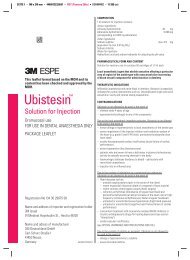EU HRT Core SPC update
EU HRT Core SPC update
EU HRT Core SPC update
Create successful ePaper yourself
Turn your PDF publications into a flip-book with our unique Google optimized e-Paper software.
treatment has been discontinued, the reason should be investigated, which may include<br />
endometrial biopsy to exclude endometrial malignancy.<br />
Breast cancer<br />
The overall evidence suggests an increased risk of breast cancer in women taking combined<br />
estrogen-progestogen and possibly also estrogen-only <strong>HRT</strong>, that is dependent on the duration<br />
of taking <strong>HRT</strong>.<br />
The randomised placebo-controlled trial, the Women’s Health Initiative study (WHI), and<br />
epidemiological studies are consistent in finding an increased risk of breast cancer in women<br />
taking combined estrogen-progestogen for <strong>HRT</strong> that becomes apparent after about3 years(see<br />
section 4.8). The excess risk becomes apparent within a few years of use but returns to<br />
baseline within a few (at most five) years after stopping treatment.<br />
<strong>HRT</strong>, especially estrogen-progestogen combined treatment, increases the density of<br />
mammographic images which may adversely affect the radiological detection of breast cancer.<br />
Ovarian cancer<br />
Long-term (at least 5-10 years) use of estrogen-only <strong>HRT</strong> products in hysterectomised women<br />
has been associated with an increased risk of ovarian cancer in some epidemiological studies.<br />
It is uncertain whether long-term use of combined <strong>HRT</strong> confers a different risk than estrogenonly<br />
products.<br />
Venous thromboembolism<br />
<strong>HRT</strong> is associated with a 1.3- to 3-fold risk of developing venous thromboembolism (VTE), i.e.<br />
deep vein thrombosis or pulmonary embolism. The occurrence of such an event is more likely<br />
in the first year of <strong>HRT</strong> than later (see section 4.8).<br />
Generally recognised risk factors for VTE include use of estrogens, older age, major surgery,<br />
prolonged immobilisation,obesity (BMI > 30 kg/m 2 ) systemic lupus erythematosus (SLE), and<br />
cancer. There is no consensus about the possible role of varicose veins in VTE.<br />
Patients with known thrombophilic states have an increased risk of VTE. <strong>HRT</strong> may add to this<br />
risk<strong>HRT</strong> is therefore contraindicated in these patients (see Section 4.3).<br />
As in all postoperative patients, prophylactic measures need be considered to prevent VTE<br />
following surgery. If prolonged immobilisation is to follow elective surgery temporarily stopping<br />
<strong>HRT</strong> 4 to 6 weeks earlier is recommended. Treatment should not be restarted until the woman<br />
is completely mobilised.<br />
In women with no personal history of VTE but with a first degree relative with a history of<br />
thrombosis at young age, screening may be offered after careful counselling regarding its<br />
limitations (only a proportion of thrombophilic defects are identified by screening). If a<br />
thrombophilic defect is identified which segregates with thrombosis in family members or if the<br />
defect is ‘severe’ (e.g. antithrombin, protein S, or protein C deficiencies or a combination of<br />
defects) <strong>HRT</strong> is contraindicated.<br />
Those women already on anticoagulant treatment require careful consideration of the benefitrisk<br />
of use of <strong>HRT</strong>.<br />
If VTE develops after initiating therapy, the drug should be discontinued. Patients should be<br />
told to contact their doctors immediately when they are aware of a potential thromboembolic<br />
symptom (e.g. painful swelling of a leg, sudden pain in the chest, dyspnoea).<br />
Coronary artery disease (CAD)
















